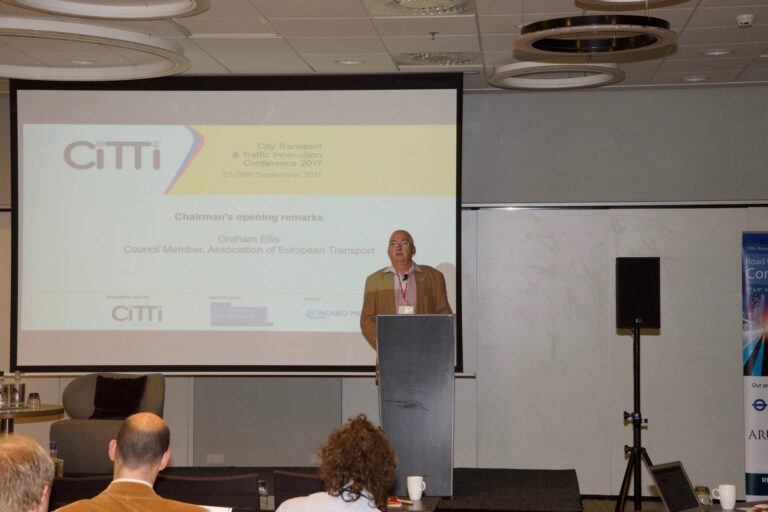Graham Ellis chaired the CiTTi conference on the 27th and 28th of September 2017 at the Marriott Hotel in Amsterdam. He shares some industry insight…
Graham Ellis, AET Council member, explores two EU projects that took sustainable transport theories and introduced real-life pilot schemes to test out those theories that had previously been developed in the STRAIGHTSOL and CITYLAB projects. Graham is part of the advisory group guiding the partners in both projects towards achievable outcomes. This gives him insight into what is being examined and what solutions have been developed as well as the opportunity to advise if the solutions can actually be used under current legislation. He shares some insight into the two projects with us:
In the case of STRAIGHTSOL there were a number of pilot projects which were designed to provide solutions to the ongoing problems. i) In Brussels TNT developed a mobile depot based upon an articulated semi-trailer which was parked in a city centre location and then had parcels collected by electric cargo bikes. ii) In Barcelona DHL set-up a city centre urban distribution centre to provide deliveries to local shops where they were only able to take small deliveries rather than truck load deliveries. Iii) In Oslo GS1 worked with a shopping centre owner to provide a delivery solution for the shops in that centre. The usual method of deliveries to the stores was for the distribution company to arrive at the loading dock, unload the delivery then take it through the centre to the store; this meant that the truck was located on the dock for a considerable period of time. The solution was to provide a delivery point at the loading dock where the lorry driver could deliver the stock to a centre security guard and the store could then call for the delivery at a time to suit them, this means that the lorry only had to stay on the dock for a short period of time, freeing the lorry to move on to the next delivery. iv) In Brussels, again, two local supermarkets Colruyt and Delhaize explored night time deliveries to reduce delays caused by daytime congestion, modified “quiet” trucks were utilised to reduce environmental problems with local residents. V) Finally in Lisbon the local authority were involved in a loading/unloading scheme where they able to manage the utilisation of parking spaces for delivery drivers, this utilised different types of technology to manage the spaces.
This project has formed the basis for a further set of pilot projects under the CITYLAB project, in this case living labs have been set-up in London, Southampton, Malmo, Rotterdam, Brussels, Paris and Rome. Again these living labs are based upon “real-life” situations; to prove or otherwise; the concepts proposed by the partners.
- i) In Southampton, Meachers’ Global Logistics, have setup a sustainable urban distribution centre that does NOT require public sector funding to keep it running, nor does it require mandatory direction to use the centre.
Ii) In London TNT are working with Gnewt cargo to operate a sustainable last mile delivery utilising electric vans, this scheme has been so successful that the company has been purchased by Menzies distribution. The TNT delivery is made in London during the night time and offloaded at the Gnewt depots, from here electric vans are used to carry out the final collection/delivery task.
Iii) In Malmo the original concept of delivery to loading docks; developed in the STRAIGHTSOL project; has been implemented at a new shopping centre called Emporia but, in this case the use of the internal transport operation is mandatory for all stores except the large supermarkets who have their own loading docks. The system also handles the reverse logistics/waste flows for the shops. A further development in Okern centrum is being designed at the moment to meet Oslo’s future shopping needs. Iv) In Rotterdam/Amsterdam TNT are examining the use of a floating depot utilising the local canals to act as a distribution base for onward collection/deliveries by electric vehicles. v)In Brussels the project is looking at utilising spare capacity on vehicles, in this case Procter and Gamble have identified that small business owners often shop for goods several times per week and tend to use their own vehicles to collect the goods, which are often not the newest vehicles on the road. The idea of the project is to book the goods online and then P&G will utilise spare capacity on suppliers vehicle to carry out the deliveries in line with their regular deliveries.vi) In Paris a totally different concept has been developed, the city of Paris decided that they needed to find a solution to inner city logistics and, in partnership with their development business (SOGARIS) they have identified a redundant rail sidings and have built a logistics village on that site. Completion is due late 2017.
vii)The final city project is based in Rome where Roma Tre University has developed a project for inwards and outward logistic flows on its campus, that proved the concept and now the university is working with the Italian post office to provide a collection service for waste recyclables. This reduces congestion in the city centre.





